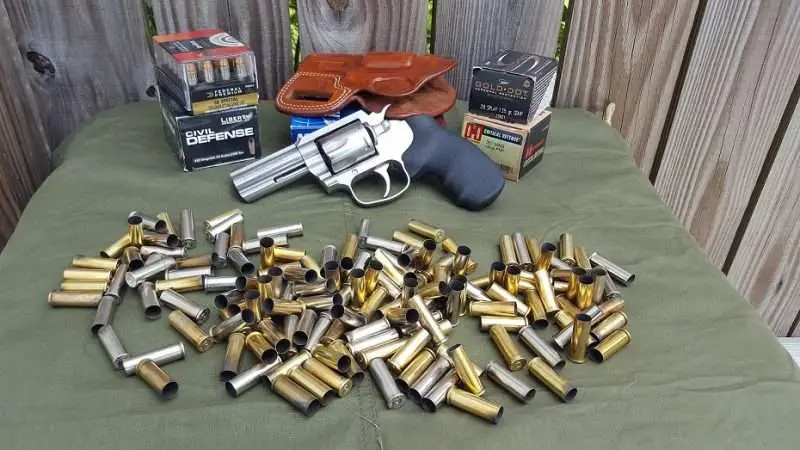
There tends to be two different trains of thought regarding self-defense ammo. The first thought says a bigger, heavier projectile is best for stopping an attack. The second one says that a smaller, but faster projectile is best.
Truth be told, either one can be correct. When comparing 9mm vs 45 ACP, for example, this is a hotly debated topic. Some folks like 9mm because it is small, fast moving, and doesn’t produce a tremendous amount of recoil.
Others like the heavier, slower moving projectiles that produce slightly more recoil with the 45 Auto. While in this conversation, rarely does anyone bring up the simple fact that you can have some of the best from both worlds with the 357 magnum, which is the topic of this article.
While the 357 Magnum usually tops out at about 158 grains for self-defense rounds (heavier for hunting purposes or animal defense), the perfect weight for our purposes here will be 125 to 135 grains.
Best 357 ammo for self-defense
- 130 grain Federal HydraShok (4 inch barrel)
- 135 grain Speer Gold Dot (2 and 4 Inch barrel)
- 125 grain Barnes TAC-XPD (2 and 4 inch barrel)
- 125 grain Hornady Critical Defense FTX (2 and 4 inch barrel)
For self-defense ammunition in any caliber, there are certain things that the bullet must do to your target:
- Penetrate to a certain depth, but no further.
- Expand to a bigger diameter without breaking apart.
And to achieve each of those, you need velocity coupled with a properly designed bullet. Let’s take a deeper look.
Bullet Penetration
First on the list, is that you need the projectile to penetrate deep enough into the attacker’s body that it does damage, but not so far that it passes straight through to hit someone or something else.
When the bullet stops inside the attacker’s body, it means that it transfers all of its energy, or power, to the target. If it passes through, not only can it hit someone or something else, but it clearly hasn’t transferred all of its energy to the target because it is still moving.
That’s where the second part comes into play.
Bullet Expansion
Your bullet needs to expand to a big enough diameter that it actually slows down because there is more surface area and resistance. And because it expands, it also does more internal damage.
When they expand and stop inside the body they transfer all of their energy to the target which is the end goal.
It’s a win win.
Bullet Speed
In order to make the above traits happen, the bullet needs to be traveling very fast. That’s one of the reasons why many people consider handgun ammunition like 380 Auto and 32 Auto to be underpowered with hollow points. They don’t travel fast enough to consistently force the bullet to mushroom out.
357 Magnum doesn’t necessarily have this problem, but you can see issues when snub nose revolvers are used with certain types of ammo.
For the 357 magnum rounds, hollow points tend to do better when moving at faster speeds. They have the necessary velocity to expand to bigger sizes when they do, and therefore, the four inch barrels tend to be better for self-defense.
There are, however, options for snub nosed revolvers. All of these options work with four inch barrels, but things get tricky with the snub nosed 357 Magnum revolvers.
The following info comes from years of experience and is backed up by the tests Lucky Gunner ran on almost 3 dozen different 357 magnum cartridge models, all designed for self-defense.
The results from those tests can be found here, or you can read on to see the ones that are the best.
Let’s take a more in depth look.
130 grain 357 Magnum Federal HydraShok
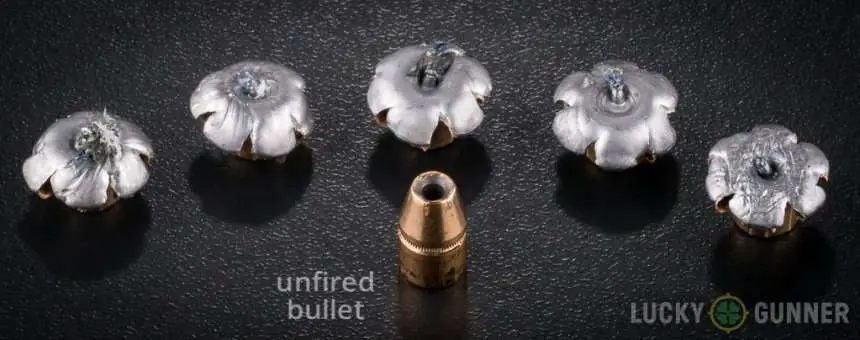
Four Inch Barrel
Out of a four inch barrel, the 130 grain Federal HydraShoks are some of the best out there that offer consistent expansion and penetration.
The HydraShoks are the granddaddy of modern self-defense ammo. While the HydraShok is outdated for many calibers, this isn’t necessarily true for the 357 Magnum with a four inch barrel.
For other, slower velocity calibers or out of a two inch barrel, they don’t expand enough to slow down and end up passing through the target about half of the time.
Because they achieve a faster speed out of a four inch 357 mag barrel, they perform better. They mushroomed out to an average diameter of .67″ and reached an average depth of 13.5 inches across five shots.
The ideal depth of penetration for self-defense ammo is 12-18 inches according to the FBI and is considered an industry standard.
These are not really suitable for shorter barrel revolvers because they do not achieve the velocity necessary to expand right. The two inch barrel robs these rounds of over 200 feet per second.
135 Grain 357 Magnum Speer Gold Dot
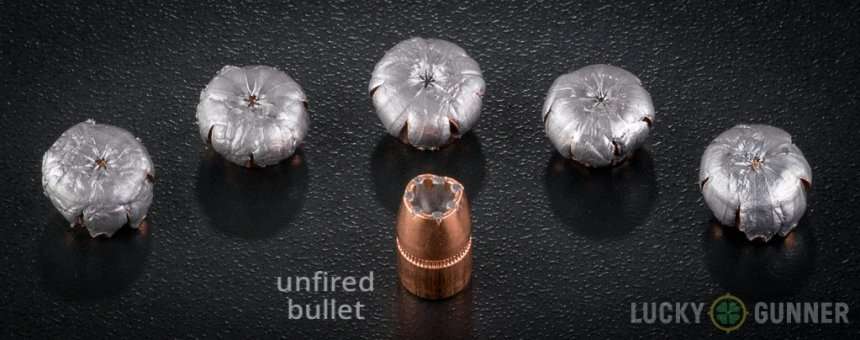
Two Inch Barrel
Things start to get a little difficult out of a two inch revolver. Part of the problem is that the bullets don’t travel at a fast enough velocity to expand properly and make it deep enough into the attacker’s body to do enough damage.
Still, there are a couple options that do good enough and are effective as man-stopping ammo. These 135 grain Gold Dots are one of those options.
They consistently expand to about .55″ and reach the minimum depth set forth by the FBI with an average of 13 inches across five shots. However, they just barely reach the proper depths with the 2 inch barrel.
Part of the problem with these rounds is that they’re somewhat underpowered by magnum standards. At the muzzle, they produce 294 pounds of energy and travel at just about 1,000 feet per second.
Learn how to read a ballistics chart here.
Four Inch Barrel
The Gold Dot rounds do better with added velocity given by the four inch barrel, traveling over 100 FPS faster at the muzzle.
They don’t expand any further, but the average distance traveled in gel is deeper. While the 2 inch barrel had a shorter distance traveled in gel, the four inch barrel puts it slightly deeper (2.5 inches deeper on average), and is therefore, in theory, more effective as an attack stopper because there is a better chance the bullet will hit a vital organ.
They travel a bit more in the body but don’t leave, meaning they transfer more energy and create more damage.
125 grain Barnes TAC-XPD
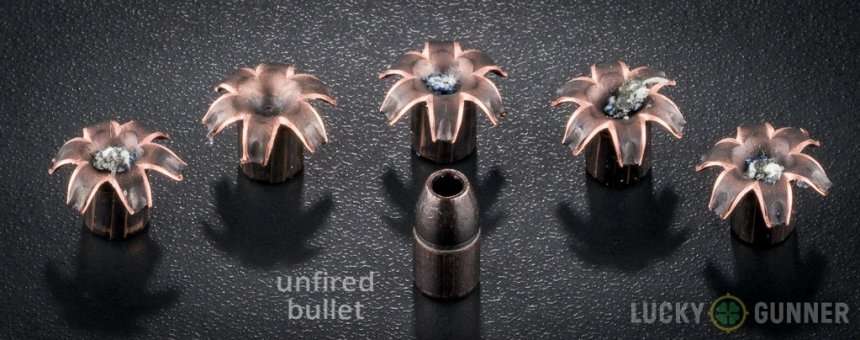
While all of the other best 357 magnum self-defense rounds presented here are lead based metal projectiles with copper jackets, these are all copper metal with a coating. These are probably the least well-known rounds on this short list.
Two Inch Barrel
The Barnes TAC-XPD consistently expand to an average of .75″ (from .357, which is impressive) when fired from a 357 Magnum with a 2 inch barrel. Those are very impressive numbers. And, they reach an average depth of 14.2″ in gel, which is right within the 12-18 inches set forth by the FBI.
The 5-shot average for velocity is over 1,200 FPS, and these are nice and powerful rounds that produce 400 pounds of energy out of a two inch barrel.
And being that they are all copper without lead, there are other benefits as well, which I won’t get into here.
Four Inch Barrel
This round also performs very well when fired from a four inch barrel. It makes it a little further into the attacker’s body with a 5-shot average of 16.1″ and is moving more than one hundred FPS faster.
Velocity average shoots up to over 1400 FPS, but the average diameter of the fired rounds drops a little bit to .69, but I believe the reason why is because the rounds are moving faster and the individual petals are pushed back faster as it travels through the body.
125 grain Hornady Critical Defense FTX
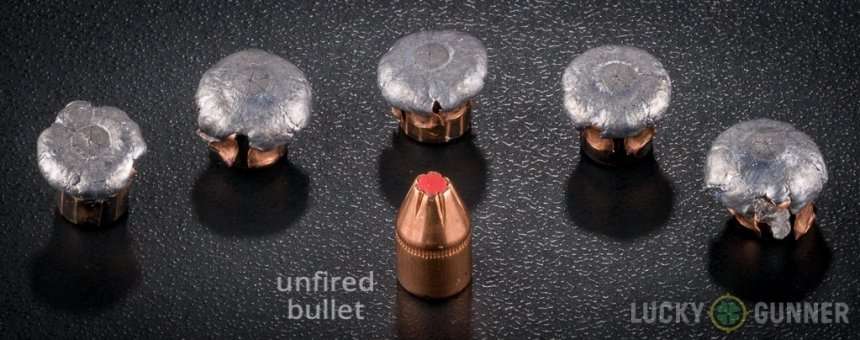
Hornady’s Critical Defense line gets a lot of hate for not consistently expanding. A lot of folks believe that their Critical Duty line is better, and maybe it is for other calibers. But for 357 Magnum, this particular load is where it’s at.
The main reason why is because the Duty line over penetrates more.
For me, personally, I choose this specific round for my magnum revolver when it’s not being used specifically for bear defense.
Two Inch Barrel
The Critical Defense rounds performed well in the snubby revolver. They expanded consistently across the five shot test they conducted, to an average .52 inches. The rounds penetrated to well within proper depths with an average of 15.3 inches into the gel.
They reached an average velocity of over 1200 FPS which helped the bullets expand properly after impacting the gelatin.
Four Inch Barrel
The Critical Defense rounds out of a four inch barrel are still well within the FBI’s specs reaching an average of 14.5 inches.
They stopped faster in the gel because the velocity was increased to an average of 1350 FPS, which caused the bullets to expand more rapidly to an average of .57 inches.
Hornady’s Critical Defense is a good option for 357 Magnum self-defense.
Conclusion:
The 357 Magnum is a very effective round when the right ammunition is used. That ammo needs to be moving fast enough that it makes it into the human body and goes far enough to do damage, while expanding to a big enough diameter that the bullet slows down before it leaves the body.
All of the above-listed rounds do a very good job of staying together as they travel through the target without breaking apart, as some ammo does.
The photos of the fired bullets belong to Lucky Gunner.


